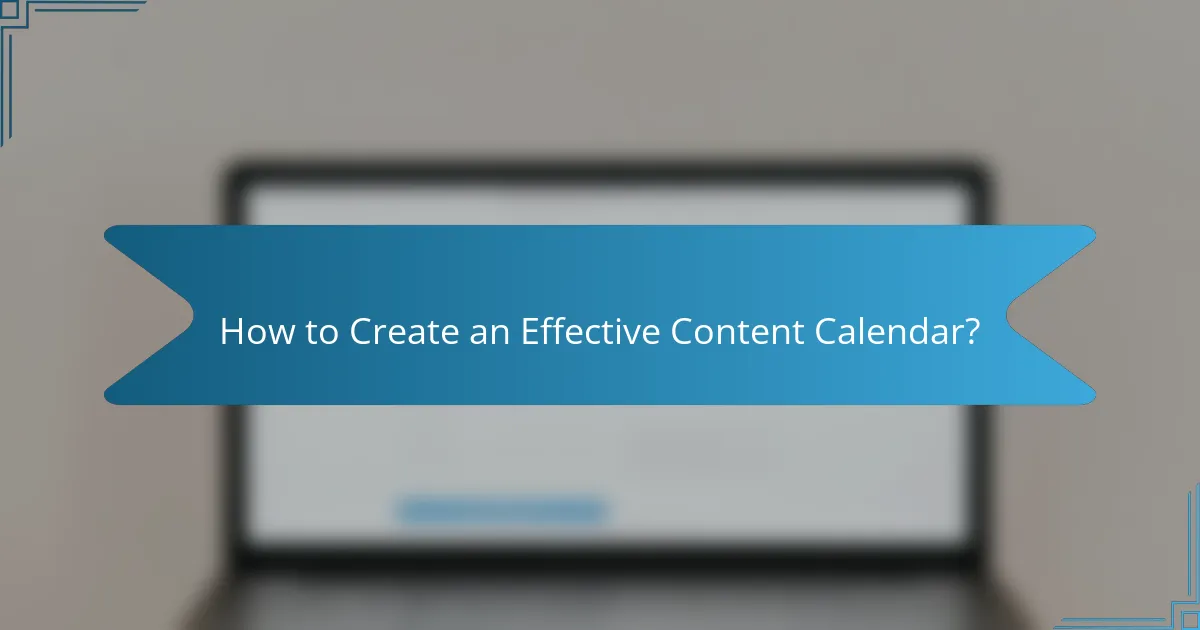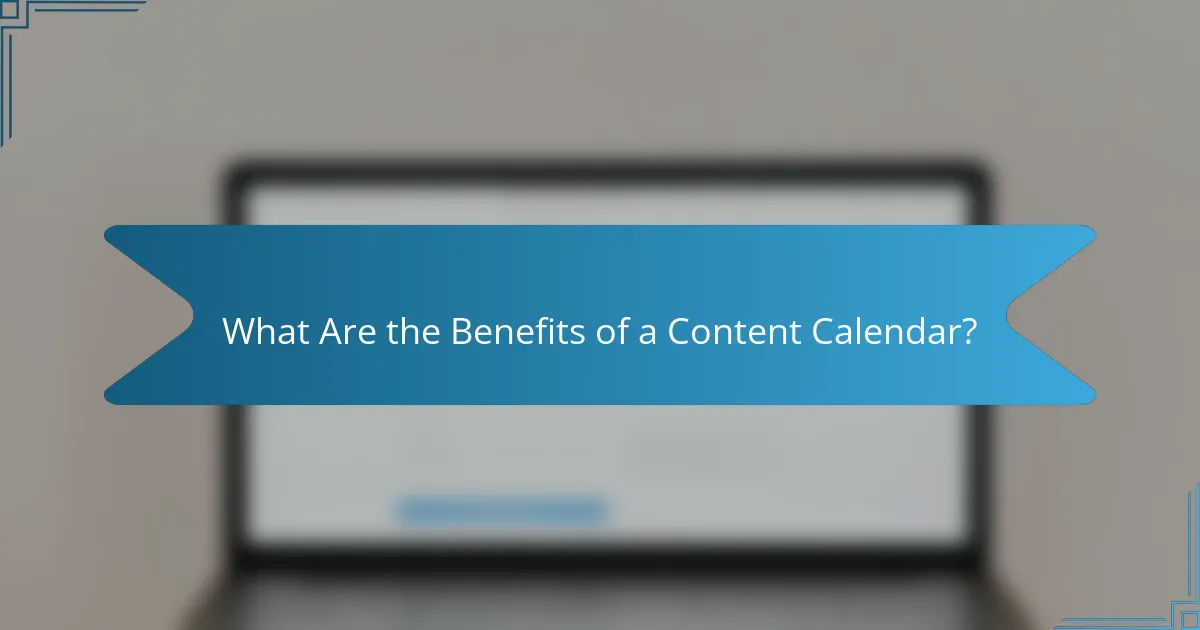A content calendar is an essential tool for effective content planning, ensuring consistency and alignment with SEO strategies. By organizing content types and scheduling publication dates, it streamlines the creation process and enhances audience engagement. Additionally, integrating keyword research and on-page SEO practices within the calendar boosts visibility and drives organic traffic.

How to Create an Effective Content Calendar?
Creating an effective content calendar involves setting clear objectives, organizing content types, and scheduling publication dates to ensure consistency and alignment with SEO strategies. A well-structured calendar helps streamline content creation and enhances audience engagement.
Define content goals
Defining content goals is crucial for a successful content calendar. Start by identifying what you want to achieve, such as increasing website traffic, boosting engagement, or generating leads. Align these goals with your overall marketing strategy to ensure coherence.
Consider using the SMART criteria—Specific, Measurable, Achievable, Relevant, and Time-bound—to formulate your goals. For example, aim to increase blog traffic by 20% over the next quarter through targeted content.
Choose a suitable format
Selecting the right format for your content calendar can enhance usability and clarity. Options include spreadsheets, digital project management tools, or specialized content calendar software. Choose a format that your team can easily access and update.
For instance, a simple Google Sheets template can work well for small teams, while larger organizations might benefit from tools like Trello or Asana that offer collaborative features and integrations.
Establish a publishing schedule
Establishing a consistent publishing schedule is vital for maintaining audience interest and improving SEO. Decide on the frequency of your content releases, whether it’s daily, weekly, or monthly, based on your resources and audience preferences.
For example, a weekly blog post combined with daily social media updates can create a balanced approach. Ensure that your schedule is realistic to avoid burnout and maintain quality.
Incorporate SEO strategies
Incorporating SEO strategies into your content calendar is essential for maximizing visibility. Research keywords relevant to your audience and industry, and plan content around these terms to enhance search engine rankings.
Consider creating a mix of evergreen content and timely pieces that capitalize on current trends. Regularly update your calendar to reflect changes in SEO best practices and algorithm updates.
Utilize content management tools
Utilizing content management tools can streamline the content creation process and improve collaboration. Tools like WordPress, HubSpot, or CoSchedule can help manage content workflows, track deadlines, and analyze performance metrics.
Choose tools that integrate well with your existing systems and offer features that suit your team’s needs, such as editorial calendars, analytics dashboards, and social media scheduling capabilities.

What Are the Benefits of a Content Calendar?
A content calendar offers numerous advantages, including improved organization, consistent publishing, and better alignment with SEO strategies. By planning content ahead of time, teams can ensure they meet deadlines and maintain a steady flow of relevant material.
Improves consistency
Consistency in content publishing is crucial for audience engagement and brand recognition. A content calendar helps teams schedule posts regularly, ensuring that content is delivered at optimal times without gaps or overlaps.
To maintain consistency, consider setting a specific frequency for your posts, such as weekly or bi-weekly. This regularity builds anticipation among your audience and can lead to increased traffic and loyalty.
Enhances SEO alignment
A well-structured content calendar can significantly enhance SEO alignment by allowing for strategic keyword planning and topic selection. By mapping out content in advance, teams can ensure that they are targeting relevant keywords and addressing trending topics.
Incorporate SEO best practices by scheduling content around seasonal trends or industry events. This proactive approach can improve search rankings and drive organic traffic, leading to better visibility in search engine results.
Facilitates collaboration
Collaboration is essential for effective content creation, and a content calendar serves as a central hub for all team members. It allows writers, editors, and marketers to see what content is planned, who is responsible for each piece, and deadlines.
To enhance collaboration, use shared tools like Google Sheets or project management software. This transparency helps prevent miscommunication and ensures that everyone is aligned with the content strategy and timelines.

How to Align Your Content Calendar with SEO?
Aligning your content calendar with SEO involves integrating keyword research, ensuring topic relevance, and applying on-page SEO practices. This alignment enhances visibility, drives organic traffic, and improves user engagement.
Keyword research integration
Effective keyword research is the foundation of a successful content calendar. Identify high-volume, low-competition keywords relevant to your audience and industry. Tools like Google Keyword Planner or SEMrush can help you discover these keywords.
Once you have a list of keywords, prioritize them based on search intent and relevance. Incorporate these keywords into your content calendar to ensure that each piece of content targets specific terms that align with user searches.
Content topic relevance
Choosing topics that resonate with your audience is crucial for SEO success. Analyze trends and user interests to create content that addresses their needs and questions. Use tools like Google Trends or social media insights to gauge what topics are currently popular.
Ensure that the topics you select not only incorporate your target keywords but also provide value and relevance to your audience. This approach fosters engagement and encourages sharing, which can further enhance your SEO performance.
On-page SEO considerations
On-page SEO elements play a significant role in how search engines interpret your content. Focus on optimizing title tags, meta descriptions, headers, and image alt texts with your chosen keywords. Each of these elements should clearly reflect the content’s focus.
Additionally, ensure your content is structured for readability, using short paragraphs and bullet points where appropriate. This not only aids user experience but also helps search engines better understand your content, improving your chances of ranking higher in search results.

What Tools Can Help with Content Calendar Management?
Effective content calendar management can be streamlined with various tools designed to enhance organization, flexibility, and automation. Choosing the right tool depends on your specific needs, such as team size, project complexity, and desired features.
Trello for organization
Trello is a visual project management tool that uses boards, lists, and cards to help organize tasks. It allows teams to create a clear workflow for content creation, making it easy to track progress and deadlines.
To get started, create a board for your content calendar and set up lists for different stages of content development, such as “Ideas,” “In Progress,” and “Published.” You can assign tasks to team members and set due dates to maintain accountability.
Google Sheets for flexibility
Google Sheets offers a flexible platform for content calendar management, allowing for easy customization and collaboration. You can create a simple spreadsheet to outline your content schedule, including columns for titles, publish dates, and status updates.
Utilize features like filters and conditional formatting to highlight upcoming deadlines or overdue items. This tool is particularly useful for teams that need to adapt quickly to changes or want to track multiple content types in one place.
CoSchedule for automation
CoSchedule is a comprehensive marketing calendar that integrates with various platforms to automate content publishing and social media sharing. This tool is ideal for teams looking to streamline their workflow and enhance productivity.
With CoSchedule, you can plan, publish, and promote your content all in one place. Its automation features help reduce manual tasks, allowing you to focus more on content quality and strategy. Consider using it if you manage a high volume of content across multiple channels.

What Are the Best Practices for Maintaining a Content Calendar?
Maintaining a content calendar involves consistent planning and regular updates to ensure alignment with your overall strategy and audience needs. Best practices include regularly reviewing the calendar, monitoring performance metrics, and making adjustments based on insights gained.
Regularly review and update
Regular reviews of your content calendar help you stay aligned with your goals and audience preferences. Set a routine, such as monthly or quarterly, to evaluate the relevance of your planned topics and adjust based on current trends or feedback.
During these reviews, consider removing outdated content ideas and adding new ones that reflect emerging topics in your industry. This keeps your content fresh and engaging, which is crucial for maintaining audience interest.
Monitor performance metrics
Monitoring performance metrics is essential for understanding how your content is resonating with your audience. Key metrics to track include engagement rates, traffic sources, and conversion rates, which can help you identify what works and what needs improvement.
Utilize tools like Google Analytics or social media insights to gather data. Regularly assess these metrics to inform your content strategy, ensuring that your calendar remains effective and aligned with your business objectives.
